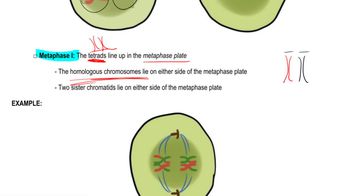Table of contents
- 1. Introduction to Genetics51m
- 2. Mendel's Laws of Inheritance3h 37m
- 3. Extensions to Mendelian Inheritance2h 41m
- 4. Genetic Mapping and Linkage2h 28m
- 5. Genetics of Bacteria and Viruses1h 21m
- 6. Chromosomal Variation1h 48m
- 7. DNA and Chromosome Structure56m
- 8. DNA Replication1h 10m
- 9. Mitosis and Meiosis1h 34m
- 10. Transcription1h 0m
- 11. Translation58m
- 12. Gene Regulation in Prokaryotes1h 19m
- 13. Gene Regulation in Eukaryotes44m
- 14. Genetic Control of Development44m
- 15. Genomes and Genomics1h 50m
- 16. Transposable Elements47m
- 17. Mutation, Repair, and Recombination1h 6m
- 18. Molecular Genetic Tools19m
- 19. Cancer Genetics29m
- 20. Quantitative Genetics1h 26m
- 21. Population Genetics50m
- 22. Evolutionary Genetics29m
9. Mitosis and Meiosis
Meiosis
Problem 28
Textbook Question
Consider a diploid cell that contains three pairs of chromosomes designated AA, BB, and CC. Each pair contains a maternal and a paternal member (e.g., Am and Ap). Using these designations, demonstrate your understanding of mitosis and meiosis by drawing chromatid combinations as requested. Be sure to indicate when chromatids are paired as a result of replication and/or synapsis.
Draw all possible combinations of chromatids during the early phases of anaphase in meiosis II.
 Verified step by step guidance
Verified step by step guidance1
Step 1: Understand the chromosome composition and the stages involved. The diploid cell has three pairs of chromosomes: AA, BB, and CC, each with a maternal (e.g., A^{m}) and paternal (e.g., A^{p}) homolog. Before meiosis II begins, DNA replication has already occurred, so each chromosome consists of two sister chromatids joined at the centromere.
Step 2: Recall that meiosis II separates sister chromatids. By the time the cell reaches early anaphase II, the sister chromatids of each chromosome are being pulled apart toward opposite poles. Importantly, homologous chromosomes were separated during meiosis I, so only sister chromatids remain paired until anaphase II.
Step 3: Identify the chromatids present at this stage. For each chromosome pair (AA, BB, CC), there are two sister chromatids: A^{m} and A^{m} (replicated sister chromatids), and similarly for A^{p}, B^{m}, B^{p}, C^{m}, and C^{p}. At early anaphase II, these sister chromatids begin to separate.
Step 4: Draw all possible combinations of chromatids moving to each pole. Since sister chromatids separate, each chromatid (e.g., A^{m} or A^{p}) moves independently to a pole. For each chromosome pair, the two sister chromatids separate, so the combinations involve one chromatid from each pair going to one pole and the other sister chromatid going to the opposite pole.
Step 5: Indicate the pairing status. At this stage, chromatids are no longer paired by synapsis (which occurs in prophase I) but were paired by replication (sister chromatids). Since anaphase II separates sister chromatids, the chromatids are now individual entities moving to poles, not paired.
 Verified video answer for a similar problem:
Verified video answer for a similar problem:This video solution was recommended by our tutors as helpful for the problem above
Video duration:
2mPlay a video:
Was this helpful?
Key Concepts
Here are the essential concepts you must grasp in order to answer the question correctly.
Chromosome Structure and Replication
Chromosomes consist of two sister chromatids joined at a centromere after DNA replication. In a diploid cell with pairs like AA, BB, and CC, each chromosome pair has one maternal and one paternal homolog. Replication duplicates each chromosome into identical sister chromatids, which are crucial for accurate segregation during cell division.
Recommended video:
Guided course

Chromosome Structure
Meiosis II and Anaphase II
Meiosis II resembles mitosis, where sister chromatids separate into individual chromosomes. During early anaphase II, the centromeres split, and sister chromatids move toward opposite poles. Understanding this phase is key to identifying possible chromatid combinations, as chromatids are no longer paired but segregating.
Recommended video:
Guided course

Meiosis Steps
Synapsis and Homologous Chromosome Pairing
Synapsis occurs during prophase I of meiosis, where homologous chromosomes pair tightly, allowing crossing over. This pairing affects chromatid combinations by exchanging genetic material between maternal and paternal chromatids. Recognizing when chromatids are paired due to synapsis helps explain genetic variation and chromatid arrangement in later stages.
Recommended video:
Guided course

Chromosome Structure
Related Videos
Related Practice
Textbook Question
Explain why meiosis leads to significant genetic variation while mitosis does not.
1126
views


